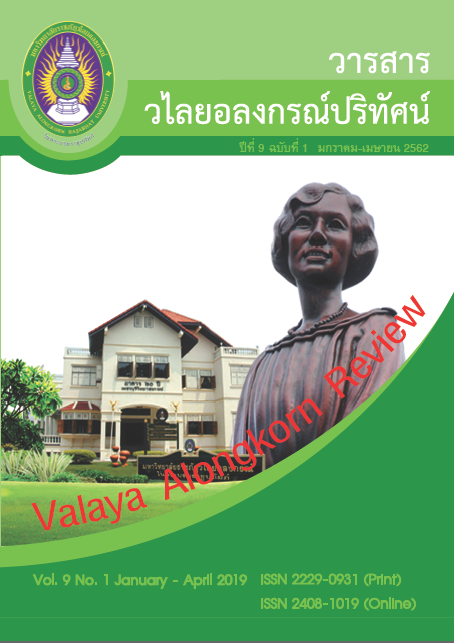การจัดการเรียนรู้ Active Learning ให้สำเร็จ
คำสำคัญ:
การจัดการเรียนรู้, การจัดการเรียนรู้แบบมีส่วนร่วม, การจัดการเรียนรู้แบบกระตือรือร้น, การจัดการเรียนรู้เชิงรุกบทคัดย่อ
การจัดการเรียนรู้ Active Learning เป็นกระบวนการจัดการเรียนรู้ที่เน้นผู้เรียนเป็นสำคัญ เน้นบทบาทและการมีส่วนร่วมของผู้เรียน โดยให้ผู้เรียนได้ลงมือปฏิบัติ เรียนรู้และดำเนินกิจกรรม ต่าง ๆ ด้วยตนเอง โดยมีครูเป็นผู้ให้คำแนะนำ ชี้แนะ กระตุ้น หรืออำนวยความสะดวก ให้ผู้เรียนได้เกิดการเรียนรู้ผ่านกระบวนการคิดวิเคราะห์ สังเคราะห์ การแลกเปลี่ยนเรียนรู้ระหว่างผู้เรียน และ การนำเสนอข้อมูล ลักษณะการจัดการเรียนรู้ Active Learning ผู้เรียนจะเป็นผู้ที่มีส่วนร่วม ในการดำเนินกิจกรรม สามารถบูรณาการความรู้เดิมกับความรู้ใหม่ เรียนรู้ และเกิดองค์ความรู้ด้วยตนเอง ซึ่งมีรูปแบบและเทคนิคของการจัดการเรียนรู้ Active Learning ที่หลากหลาย โดยผู้สอนสามารถนำมาใช้ออกแบบแผนการจัดการเรียนรู้ให้เหมาะสมกับกิจกรรมการเรียนรู้ เหมาะสม กับผู้เรียน กระตุ้นให้ผู้เรียนมีส่วนร่วมในชั้นเรียน ส่งเสริมปฏิสัมพันธ์ระหว่างผู้เรียนกับผู้เรียนและผู้เรียนกับผู้สอน ส่งผลให้ผู้เรียนเกิดประสบการณ์และความสำเร็จในการเรียน เป็นการจัดการเรียนรู้ ที่มุ่งเน้นพัฒนากระบวนการเรียนรู้ ส่งเสริมให้ผู้เรียนประยุกต์ใช้ทักษะ และเชื่อมโยงองค์ความรู้นำไปปฏิบัติเพื่อแก้ไขปัญหาหรือประกอบอาชีพในอนาคต และถือเป็นการจัดการเรียนรู้ประเภทหนึ่งที่ส่งเสริม ให้ผู้เรียนมีคุณลักษณะสอดคล้องกับการเปลี่ยนแปลงในยุคปัจจุบัน
เอกสารอ้างอิง
จิตณรงค์ เอี่ยมสำอางค์. (2558). Active Learning แนวทางการจัดการเรียนรู้สำหรับผู้เรียนในยุคศตวรรษที่ 21. [ออนไลน์], เข้าถึงได้จาก: http://chitnarongactivelearning.blogspot.com (2562, 9 มกราคม).
ณัชนัน แก้วชัยเจริญกิจ. (2550). ภาวะผู้นำและนวัตกรรมทางการศึกษา: บทบาทของครูกับ Active Learning. [ออนไลน์], เข้าถึงได้จาก: http://www.pochanukul.com. (2554, 22 มีนาคม).
ดิเรก พรสีมา. (2559). ครูไทย 4.0. กระทรวงศึกษาธิการ. [ออนไลน์], เข้าถึงได้จาก: http://www.moe.go.th/moe/th/news/detail.php?NewsID (2562, 5 มกราคม).
ดุษฎี โยเหลา และคณะ. (2557). การศึกษาการจัดการเรียนรู้แบบ PBL ที่ได้จากโครงการสร้างชุดความรู้เพื่อสร้างเสริมทักษะแห่งศตวรรษที่ 21 ของเด็กและเยาวชน: จากประสบการณ์ความสำเร็จของโรงเรียนไทย. กรุงเทพฯ: ทิพย์วิสุทธิ์.
เดชดนัย จุ้ยชุ่ม, เกษรา บ่าวแช่มช้อย และศิริกัญญา แก่นทอง. (2559). การพัฒนาผลสัมฤทธิ์ทางการเรียน เรื่อง ทักษะการคิดของนักศึกษาในรายวิชา ทักษะการคิด (Thinking Skills) รหัสวิชา 11-024-112 ประจำภาคเรียนที่ 1 ปีการศึกษา 2558 ด้วยการเรียนรู้แบบมีส่วนร่วม (Active Learning). คณะศิลปศาสตร์ มหาวิทยาลัยนราธิวาสราชนครินทร์.
ทิศนา แขมมณี. (2551). รูปแบบการเรียนการสอน. กรุงเทพฯ: สำนักพิมพ์แห่งจุฬาลงกรณ์ มหาวิทยาลัย.
บัณฑิต ทิพากร. (2550). “การพัฒนาคณาจารย์ในสถาบันอุดมศึกษา”. ใน ไพทูรย์ สินลารัตน์ บรรณาธิการ อาจารย์มืออาชีพ: แนวคิด เครื่องมือ และการพัฒนา. กรุงเทพฯ: โรงพิมพ์จุฬาลงกรณ์มหาวิทยาลัย.
เยาวเรศ ภักดีจิตร. (2557). Active Learning กับการพัฒนาผู้เรียนในศตวรรษที่ 21. นครสวรรค์: สาขาวิชาสังคมศึกษา คณะครุศาสตร์ มหาวิทยาลัยราชภัฏนครสวรรค์.
วิทวัส ดวงภุมเมศ และวารีรัตน์ แก้วอุไร. (2560). การจัดการเรียนรู้ในยุคไทยแลนด์ 4.0 ด้วยการเรียนรู้อย่างกระตือรือร้น. วารสารมนุษยศาสตร์และสังคมศาสตร์ บัณฑิตวิทยาลัย มหาวิทยาลัยราชภัฏพิบูลสงคราม. 11(2), 1-4.
สถาพร พฤฑฒิกุล. (2558). เอกสารประกอบการฝึกอบรม “คุณภาพผู้เรียนเกิดจากกระบวนการเรียนรู้”. สระแก้ว: คณะเทคโนโลยีการเกษตร มหาวิทยาลัยบูรพา วิทยาเขตสระแก้ว.
สุพรรณี ชาญประเสริฐ. (2557). Active Learning: การจัดการเรียนรู้ในศตวรรษที่ 21. นิตยสาร สสวท. 42(188), 3-6.
Bonwell, C. C., & Eison, J. A. (1991). Active Learning: Creating Excitement in the Classroom. ASHE-ERIC Higher Education Report No. 1. Washington, D.C.: The George Washington University, School of Education and Human Development.
Center for Teaching Innovation. (2562). [Online], Available: http://www.cte.cornell.edu (2019, 25 January).
Ewell, P. T. (1997). Organizing for learning: A new imperative. AAHEA Bulletin-American Association for Higher Education. 50(4), 3-6.
Felder, R. & Brent, R. (1996). Navigating the Bumpy Road to Student-Centered Instruction. Journal of College Teaching. 44(2), 43-47.
Fink, L. D. (1999). Active learning. [Online], Available: http://www.honolulu. hawaii.edu/intranet. (2017, 21 January).
Gifkins, J. (2015). What Is ‘Active Learning’ and Why Is It Important?. E-international relations. [Online], Available: http://www.e-ir.info/2015/10/08/what-is-active learning-and-why-is-it-important. (2019, 23 January).
Johnson, D. W. (1991). Cooperation in the classroom. American Psychological Association.
Mckinney, S. E. (2008). Developing teachers for high-poverty schools: The role of the internship experience. Urban Education. 43(1), 68-82. [Online], Available: http://www.eric.ed.gor (2018, 2 January).
Meyers, C., & Jones, T. B. (1993). Promoting Active Learning: Strategies or the College Classroom. San Francisco: Josey-Bass Publishers.
Shenker, J. I., Goss, S. A., & Bernstein, D. A. (1996). Instruction’s Resource Manual for Psychology: Implementing Active Learning in the Classroom. [Online], Available: http://www.s.psych/uiuic.edu/~jskenker/active.html. (2019, 23 January).
Standford Teaching Commons. (2015). Course Design Overview. [Online], Available: https://teachingcommons.stanford.edu (2018, 3 December).
ดาวน์โหลด
เผยแพร่แล้ว
รูปแบบการอ้างอิง
ฉบับ
ประเภทบทความ
สัญญาอนุญาต
ข้อความที่ปรากฏในบทความแต่ละเรื่องในวารสารวไลยอลงกรณ์ปริทัศน์ เป็นความคิดเห็นของผู้นิพนธ์แต่ละท่าน มิใช่เป็นทัศนะและมิใช่ความรับผิดชอบของกองบรรณาธิการจัดทำวารสาร และ
มหาวิทยาลัยราชภัฏวไลยอลงกรณ์ ในพระบรมราชูปถัมภ์


